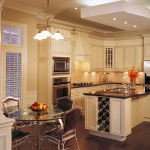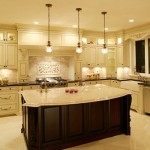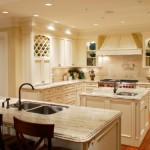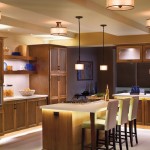Kitchen Lighting Tips
Kitchen Lighting Tips
Lighting Kitchen
Kitchen lighting is probably harder than any other space in the house. First, all work areas need adequate task light of the right color and intensity. The room also needs ambient light for general illumination. If a dining area is part of the kitchen, it should be lit with a source that fosters enjoyment of the meal. Can all these goals be met? The answer is yes, with sensitive lighting strategies.
Lighting Work Areas
Food preparation is a demanding task, so the goal of task lighting is to put the light on the work surfaces, most of which are on countertops around the periphery of the room. In the quest for economy, many mass-produced houses light the entire kitchen with a single fixture in the center of the ceiling, with the worst possible results, guaranteed to cast the cook's shadow on any work surface not directly under the fixture. A much better approach is to locate fixtures at the ceiling just in front of the wall cabinets or under the wall cabinets. Ranges can be lit with lights built into range hoods. If you are designing a custom hood, it too should contain a fixture. For downdraft ventilating ranges, mount a recessed or surface-mounted fixture above the range.
The best location for countertop lighting is below the wall cabinets, with the fixtures mounted near the front edge. Lamps mounted here throw their light directly on the work surface, with no objects intervening to cast a shadow.
If you choose to light the countertop from the ceiling, locate the fixtures close enough to the wall so that they won't cast the user's shadow on the countertop, but with enough clearance for the doors of the wall cabinets to open. Fixtures can be recessed or surface-mounted on the ceiling or recessed into an overhanging soffit. Can lights and spots work well at the ceiling level and if mounted in tracks, enable the homeowner to adjust their location and focus.
The Rest of the Kitchen
Successful ambient lighting provides evenly distributed light that doesn't cause glare or discomfort. The single fixture in the center of the ceiling, mentioned earlier, may satisfy the first need, but not the second, since anyone sitting in the room can't look up at the ceiling without squinting. If a dining area is included as part of the kitchen—on an island or separate table it should be lit with a source that provides both enough light to see the food and create the mood to want to eat it. But these needs are not the same for every meal. The breakfast eaten quickly on a dark morning needs a different quality light than a fancy dinner intended to be enjoyed in a relaxed atmosphere. The answer to this is a pendant centered over the dining surface. Another possibility is surface-mounted or recessed cans. If there is a wall surface, a sconce might work. In any case, the fixture should be connected to a dimmer switch, so that the lighting level can be adjusted to suit the mood.
Accent Lighting
As homeowners regard kitchens as living space, as well as a place to prepare food, they increasingly want to display art, china and collectibles in the kitchen. Wall-mounted art can best be lit with adjustable fixtures mounted on the ceiling at a distance of 24 to 30 inches (610 mm to 762 mm) out from the wall. Another solution is recessed ceiling fixtures.For china and other items displayed behind glass doors, you'll get a good effect with small low-voltage strip lighting, such as xenon strips, mounted atop the cabinet just behind the door.




